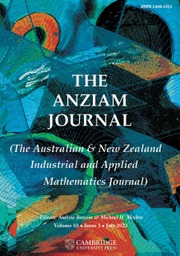No CrossRef data available.
Article contents
WAVE INTERACTION WITH AN H-SHAPED SUBMERGED BREAKWATER
Published online by Cambridge University Press: 15 September 2025
Abstract
We present a study of oblique-wave scattering by an H-shaped breakwater submerged in deep water. The H-shaped breakwater is designed using two thin vertical plates connected by a thin horizontal plate. The velocity potentials that describe the wave motion in different regions are expressed using the Havelock expansion. Two first-kind Fredholm-type integral equations are derived by applying the continuity of fluid velocity and pressure at the interface for the horizontal component of fluid velocity across the gap below and above the breakwater. The coefficients of wave reflection and transmission are derived in explicit forms that require the solution of integral equations. The solutions of integral equations are obtained by employing the Galerkin approximation that involves simple polynomials. In some limiting cases, wave scattering by submerged  $\large \boldsymbol {\sqcap }$ and
$\large \boldsymbol {\sqcap }$ and  $\large \boldsymbol {\sqcup }$-shaped breakwaters is also studied. The correctness of the results is verified by comparing them with existing results reproduced in a limiting case and checking the wave energy balance equation. The results reveal that the H-,
$\large \boldsymbol {\sqcup }$-shaped breakwaters is also studied. The correctness of the results is verified by comparing them with existing results reproduced in a limiting case and checking the wave energy balance equation. The results reveal that the H-,  $\large \boldsymbol {\sqcap }$- and
$\large \boldsymbol {\sqcap }$- and  $\large \boldsymbol {\sqcup }$-shaped breakwaters show low wave transmission for most incident wavelengths. The horizontal plate between the vertical plates accounts for this low wave transmission. Wave forces and the overturning moment are also calculated. These breakwaters may be used in water regions that require low wave transmission.
$\large \boldsymbol {\sqcup }$-shaped breakwaters show low wave transmission for most incident wavelengths. The horizontal plate between the vertical plates accounts for this low wave transmission. Wave forces and the overturning moment are also calculated. These breakwaters may be used in water regions that require low wave transmission.
Keywords
MSC classification
Information
- Type
- Research Article
- Information
- Copyright
- © The Author(s), 2025. Published by Cambridge University Press on behalf of the Australian Mathematical Publishing Association Inc.


